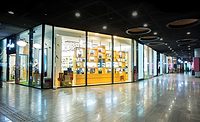Addressing retail theft with an intelligent loss prevention approach

Image via Unsplash
Shrink is hardly a new phenomenon in the retail industry, but the problem has been steadily growing. In 2022, estimated losses due to shrink reached almost $100 billion, underscoring the continuing challenge of defending against organized retail crime (ORC), employee theft, fraud and other illegal behavior. The problem reached a crescendo during the pandemic years, with 88% of retailers included in the most recent National Retail Security Survey (NRSS) indicating that the pandemic led to an increase in overall risk. There was also a 26.5% increase in organized retail crime observed by retailers between 2021 and 2022 — a significant increase for a single year.
These problems are not going to go away — if anything, they will only get worse. Fortunately, the security technology available to retailers has come a long way in the past decade. They are no longer limited to stationary cameras manually monitored by security personnel hidden away in a back room. Today’s solutions are more responsive, more intelligent and more effective when it comes to identifying suspicious behavior and alerting security teams in real time. Today’s retailers have the ability to take an intelligence-led approach to security, leveraging modern devices and advanced, AI-driven analytics to turn loss prevention into a proactive operation rather than a reactive one.
An integrated solution is the answer
The image quality provided by modern surveillance cameras has improved dramatically, but that isn’t the only factor that has impacted security. Today’s devices are also significantly more powerful, allowing them to run advanced analytics on the network edge rather than sending video to a server or the cloud for analysis. Thanks to edge processing improvements, only metadata (and perhaps a short video clip) needs to be sent to the server or cloud, dramatically reducing both storage and bandwidth costs. These advanced new processors are now standard on many security devices, meaning modern analytics solutions are both more affordable and more accessible to today’s retailers.
Of course, no single device or solution can solve the problem of retail crime. Loss prevention needs to be addressed in a more holistic way, which means retailers are best served by prioritizing open-platform technology capable of integrating with a wide range of devices and solutions. Open-platform technology makes it possible to integrate solutions from different providers on an as-needed basis, rather than being locked into a single product line. It also makes it easier for those solutions to talk to one another — something that is absolutely critical for an intelligence-led approach to loss prevention.
Putting modern analytics to use
Retailers put this into action in a variety of different ways. A camera positioned outside the store might use object recognition analytics to identify human figures approaching in the middle of the night. Once an event is detected by the camera, the metadata is sent from the camera to the video management system (VMS) or cloud, which generates an alert to let security personnel know a potential incident is occurring. Some stores might choose to integrate it with an audio solution that can play an automated warning message, letting the trespasser know they are being recorded. And if the suspicious person ignores that message, law enforcement can be notified. Similarly, a pan/tilt/zoom (PTZ) camera monitoring the grounds might be equipped with audio detection that can tell the camera to focus on an area where the sounds of breaking glass or raised voices have been detected and respond accordingly.
Inside stores, cameras can be programmed to look for known signs of ORC, such as customers behaving aggressively or loitering in certain areas. They can be programmed to notify security if a large group of customers walk into the handbag or jewelry department minutes before closing. PTZ cameras can be linked to wireless smart devices and programmed to turn toward a secure door when it opens. A panic button under a point-of-sale system can be linked to those same cameras, telling them to zoom in on the face of an assailant and alert both security and law enforcement when triggered. Motion sensors can be installed in low-traffic areas, with cameras set to take a picture when tripped. These capabilities are all contingent on integrated solutions being able to talk to one another — and they all play a critical role in modern retail security.
Modern cameras are also very good at classifying data and looking for patterns, making it easy to search through recordings when necessary. This makes it easier to find lost children based on their clothing or appearance. It also makes it easier to track a suspicious individual throughout the store: just tell the video analytics solution what to search for, and it can display everywhere that person was detected on the store’s camera system. It can also play a major role in detecting internal fraud: if, for example, losses are detected in the stockroom on certain days, security personnel can search through recorded data to see which employees are regularly entering the stockroom on those days and look for patterns.
These integrations can even impact loss prevention in ways that go beyond retail crime: certain analytics can detect things like precariously stacked objects, unaddressed spills or blocked emergency exits, aisles, electrical panels or fire extinguishers. Quickly and automatically issuing alerts to remediate those problems can save businesses from tens of thousands of dollars in potential OSHA fines — and while that might not fall under the typical definition of “loss prevention,” it does have a significant impact on the business’s bottom line. It’s also worth noting that computer vision technology is improving with each passing year, and while it isn’t widely available yet, its potential is impressive. Computer vision is excellent at detecting behavior outside the norm, such as a person grabbing an entire shelf of expensive items or failing to scan items at a self-checkout terminal. This emerging technology will soon provide significant benefits for loss prevention teams.
Don’t be an easy target
Almost 75% of retailers say that external theft has increased over the past five years, while another 56.9% say internal theft has also increased over that same span. The problem of shrink is here to stay — which means it is up to retailers to decide what to do about it. Fortunately, modern security technology has put new tools in the hands of loss prevention teams, allowing them to detect potential security incidents more accurately and deal with them more quickly and effectively — and integrating those solutions creates a valuable force multiplier effect that can help retailers avoid becoming an easy target for criminals.
Looking for a reprint of this article?
From high-res PDFs to custom plaques, order your copy today!








